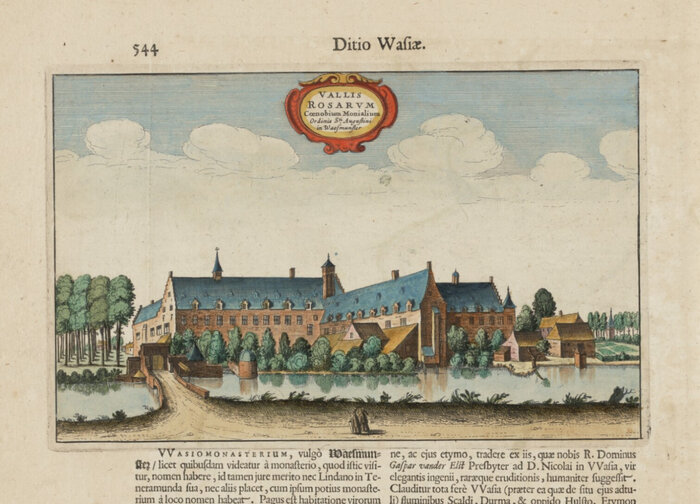
Roosenberg I
In 1237, Walter de Marvis (1175-1252), bishop of Tournai, Ghent and Bruges arranged for several sisters from Tournai to transfer to the Waes Monasterium in Waasmunster to establish a community of Victorine nuns. They lived according to the rule of St. Augustine. Walter de Marvis also had great admiration for Francis of Assisi, who he had met during the Fifth Crusade.
The principles behind the Rule of Augustine were founded on the dream of Jerusalem's first community. Love and community were at the heart of everything. In practice, the ideal of a good community was simply about creating loving relationships. The rule of Augustine called for evangelic equality of all people and for proper brotherhood and sisterhood among everyone. Implicitly it protested against the inequality in society, which was so heavily marked by greed, conceit and power.
The sisters settled close to the Durme and received official recognition of their foundation from Pope Alexander IV as early as 1258. Yet they were not spared from suffering and difficulties. Their abbey was destroyed twice during the Ghent Uprisings (1379 and 1459). In 1419, the building burned down and in 1578 the Calvinists moved in. The abbey was redeveloped on each occasion. The community kept going up until the French Revolution, but then the abbey was declared confiscated, used as a barracks and dismantled in 1797. The sisters were banished.

Etching of Roosenberg I from Flandria Illustrata by Sanderus
Roosenberg II
Thanks to the escape of abbess Anna Maria de Crombrugge, many precious documents were saved and the seed was also planted for the re-emergence of Roosenberg. In 1830, it was Joanna Maria van Doorselaer de ten Ryen who used her own means to track down the remaining sisters in order to restore the abbey. New candidates soon came to join and the community was able to flourish once more.
From 1970, the abbey faced a new crisis. Due to the lack of recruits, it was necessary – under the orders of the bishop of Ghent – to merge the abbey with the congregation of the Franciscan sisters of Mary.

Portrait of abbess Joanna Maria van Doorselaer de ten Ryen (1782-1863)
Roosenberg III
The sisters decided to retreat into nature and commissioned Doms Hans van der Laan to design their new convent. On 6 August 1975, the brand new building complex was ready for the kick-off of Roosenberg III. The abbey was a modernistic complete work of art, whereby not only the building, but also all of the interior was the work of van der Laan.
The sisters remained in Roosenberg III until 2016, when finally the last residents moved to the centre of Waasmunster. Since then, a search has been ongoing to find a suitable purpose for the extraordinary abbey complex. A purpose that does justice to the unique heritage of van der Laan. In 2023, the 50-year leasehold of Roosenberg abbey was acquired by Herita. Herita will endeavour to make this historic site accessible to the general public.

Roosenberg II, a design by Dom Hans van der Laan from 1975

List of abbesses
- Agnes (1238 – circa 1247)
- Gijsle (1247 – 1271)
- Aleidis (1271 – 1279)
- Beatrijs (1280 – )
- Elisabeth Mulaert (1295 – voor 1317)
- Maria (voor 1317 – voor 1331)
- Elisabeth Baef (voor 1331 – na 1333)
- Elisabeth (na 1333 – voor 1353)
- Maria Hingels (1353/1354 – )
- Maria van der Vesten ( )
- Clara van Coudenborg ( )
- Margareta van Dale ( – 1415)
- Margareta Thierens (1419 – 1432)
- Beatrijs van der Bochagen (1433 – 1474)
- Amelberga Boots (1474 – 1504)
- Judoca van Steelant (1504 – 1550)
- Francisca de Almaraz (1550 – 1583)
- Philippote Triest (1585 – 1610)
- Anna de Samillan (1610 – 1634)
- Regtna de Croeser (1634 – 1645)
- Elisabeth Goossens (1645 – 1658)
- Magdalena Daelmans (1658 – 1665)
- Anna Nonnius (1665 – 1685)
- Jacoba van der Haeghen (1685 – 1698)
- Maria Sivori (1698 – 1722)
- Ther esta de Belver (1722 – 1741)
- Isabella van Hove (1741 – 1749)
- Beatrijs van Horenbeke (1749 – 1766)
- Maria-Anna de Crombrugghe (1766 – 1812)
- Johanna van Doorslaer de ten Ryen (1832 – 1863)
- Gertrude van den Dorpe (1863 – 1866)
- Joanna van Raemdonck (1866 – 1873)
- Aloysta De Cock (1873 – 1925)
- Joanna Pintelon (1925 – 1962)
- Filomena Schatteman (1962 – 1968)